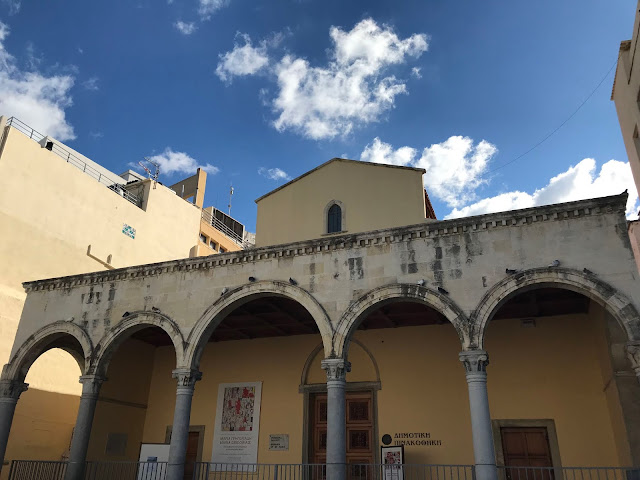After visiting the ancient ruins at Knossos, we ventured into Crete's major city of Heraklion. Above is the church of St. Titus. Titus was an apostle of St. Paul and the first bishop of Crete.
Paul wrote a letter to Titus.
"Remind them to be under the control of the magistrates and authorities, to be obedient to every good enterprise. They are to slander no one, to be peaceable, considerate, exercising all graciousness toward everyone. For we ourselves were once foolish, disobedient, deluded, slaves to various desires and pleasures, living in malice and envy, hateful ourselves and hating one another.
But when the kindness and generous love
of God our savior appeared,
not because of any righteous deeds we had done
but because of his mercy,
he saves us through the bath of rebirth
and renewal by the holy Spirit,
whom he richly poured out on us
through Jesus Christ our savior,
so that we might be justified by his grace
and become heirs in hope of eternal life."
Titus 3:1-7St. Titus's relics are other places, including Venice (more on this later) but above his skull is enclosed in this glittery helmut.
Above and below, more beautiful scenes from St. Titus. Those Byzantine artists really emphasized the abs.
Above is the Loggia, a building constructed by the Venetians during their 400 year plus rule of Crete beginning in 1204.
 |
| Statue of El Greco in Heraklion, Crete |
Above is El Greco's Adoration of the Shepherds.
Venice left its mark on Crete, in part through its long and interesting connection to St. Mark, involving stolen relics. A major Basilica to St. Mark is located in Venice. St Mark's in Peoria, Illinois is my home parish. When the Venetians came to Crete they built the Basilica de San Marcos in 1239.
The Basilica is now an art gallery, which, unfortunately, was closed when we were there.
There was an exhibition by an artist named Maria!
Another view of the Basilica de San Marcos in Crete with the distinctively Venetian high arches and thin columns.
Not far from the Basilica was the Morozini Fountain with the lions. The lion is the symbol of St. Mark the Evangelist.
Close to the fountain a boy and his dog entertain the passersby. On Crete, one of our fellow travelers got lost. There were some tense moments, waiting on the bus. Would we make it back in time to board the ship before she sailed? Three of our pilgrims fanned out looking for him. Success! They found him! So many times in my own life I feel lost. God must feel about me a little like we felt about our fellow traveler. "Come back to me!"





























